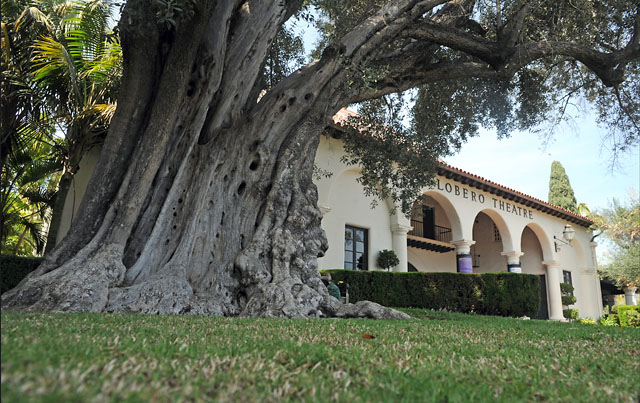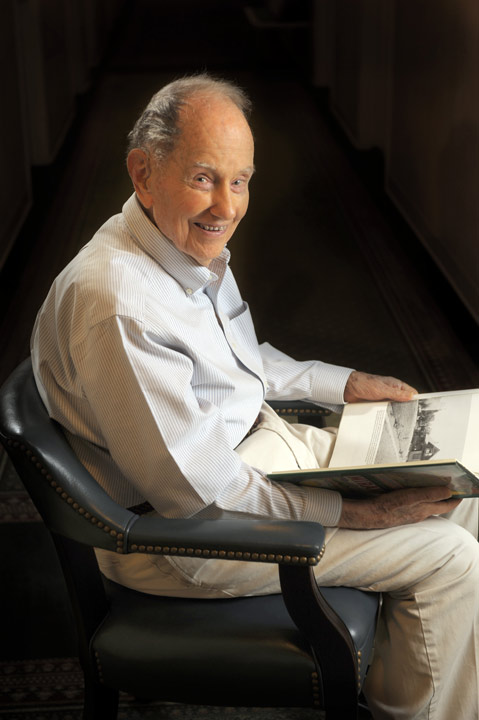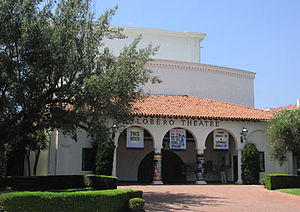Leave It Be
Don't Trade Architecture for Food Carts

The Lobero Theatre is a landmark and is so designated by the state and the city. As reported in The Santa Barbara Independent, the Lobero Theater Foundation has embarked on a fundraising campaign to fund a needed, extensive updating of this 1924 historic building. These projects include heating, air conditioning, new seats, a larger women’s restroom. A level terrace surrounded by a seating wall at the front entrance is proposed.
It is this terrace, called an “esplanade,” accessed by a flight of steps from Canon Perdido Street, that I wish to bring to public attention. As one who has been honored by this journal as a Local Hero for my advocacy in saving Santa Barbara landmarks, I must speak out.
This new design feature will remove the 1924 brick-paved sloping entrance to the Lobero Theatre, which is identified in the 2012 Historic Structures Report prepared for the Historic Landmarks Commission as one of the “character-defining features of the property.” The reason given for constructing this walled esplanade is to provide a level surface for a wine bar and food carts, for use during intermissions.

This esplanade, because it’s elevated, is aloof and detached from the street, and will make the building and its function seem removed and exclusive as well. The sloping brick plaza, in contrast, serves as public space that connects the building to the street. The message is one of welcome and inclusion.
The Encore Lobero campaign claims that the esplanade was part of the original design-intent of the architect, George Washington Smith. A plan showing an entrance accessed by steps was found in the architectural archives of UCSB. Obviously, this plan was rejected, probably by Smith himself.
Mr. Smith had been hired in 1922 to remodel the 1873 1,300-seat theater, which had been purchased by the recently established Community Arts Association that encompassed all the arts, drama, music, dance, fine arts architecture, and even gardening. The Drama Branch, which was already producing a dozen plays a year, needed a theater of its own. At first, the Community Arts Association thought it could restore the old theater. A structural engineer hired to examine the adobe brick building declared the structure unsound, and it would be impossible to make it safe.
Smith, who had already drawn plans for the 1,300-seat-building remodel, was asked by the Association to change his design. The Drama Committee wanted a smaller structure, one in which the whole community could participate. It did not want a venue that would be in competition with the then extant 1,100-seat Potter Hotel Theater on the corner of State and Montecitio Streets. His design for a smaller, 680-seat theater, set back from Canon Perdido Street, was accepted. It is what is on the ground today, a Santa Barbara landmark.

The sloping brick terrace entrance was, I believe, Smith’s decision. Following Andalusian models, most of the front entrances to buildings designed by Smith have the entrance level with the driveway or walkway. Examples are Casa del Herrero and the News-Press building. Also influencing Smith’s decision, perhaps, was the need for an unobstructed, large open plaza for opening night celebrations, which could accommodate floats, large floral displays, and searchlights. The first celebration, in 1924, was the start of Santa Barbara’s annual fiesta.
My father, landscape architect Lockwood de Forest, was brought in to provide an appropriate landscape treatment. I was told this growing up. Supporting my memory is an unsigned and undated plan found in the Lockwood de Forest collection at the UC Berkeley Environmental Design Archives in a file titled “Lobero Theater.” They show the brick walkway plaza and the olive trees labeled in my father’s hand. My father used olive trees extensively, believing that the olive’s gray-green color best augmented Smith’s Spanish Revival architecture.
The Lobero’s external space is a significant cultural landscape feature. Why features by a nationally famous architect and landscape architect need to be destroyed all for a food cart at intermission needs explanation. The Encore Lobero plans will compromise a 90-year-old landmark. Another piece of Santa Barbara heritage will be lost. I realize that there are Americans with Disability Act regulations, but with all the architects and landscape architects in Santa Barbara surely a way can be found to preserve George Washington Smith’s brick-plaza slope and Lockwood de Forest’s olive trees. Join me and others interested in preserving Santa Barbara’s landmarks by writing Doug Wood, the president of the Lobero Theatre Foundation, 33 East Canon Perdido St., Santa Barbara CA 93101.



